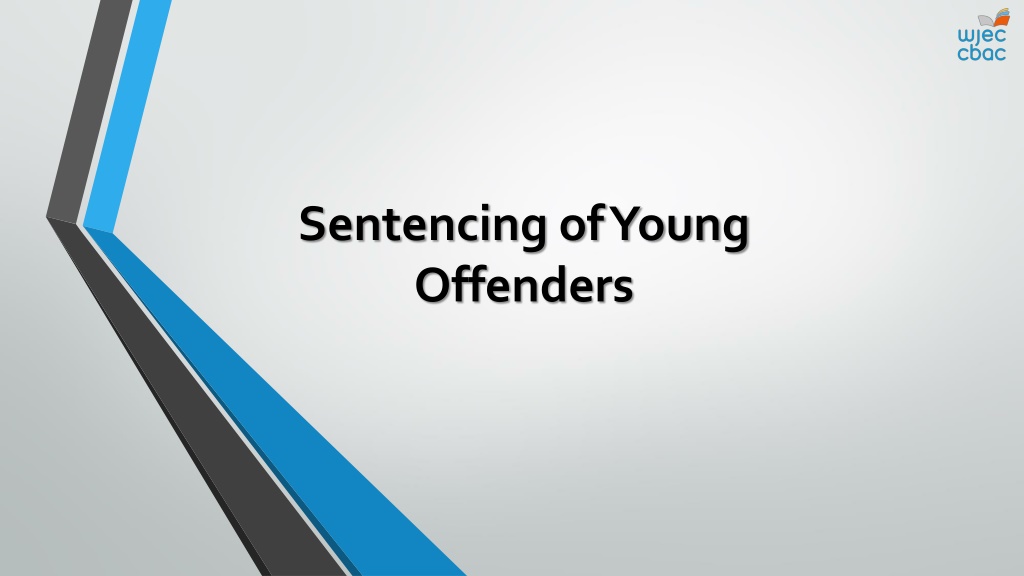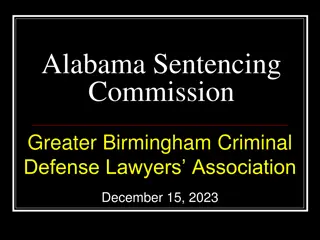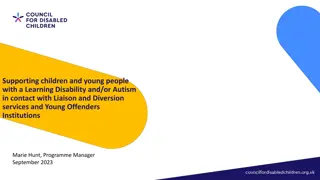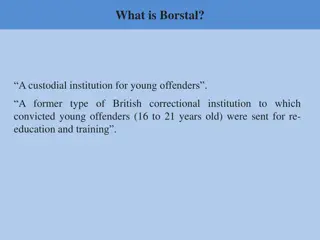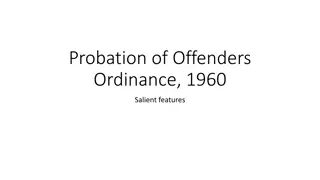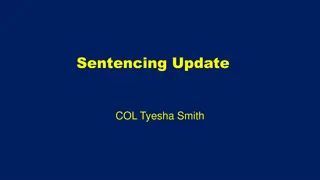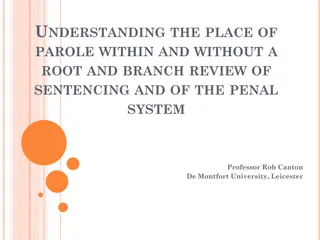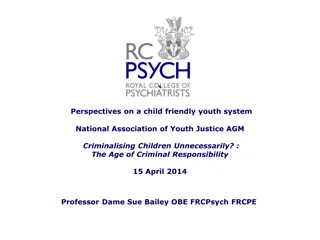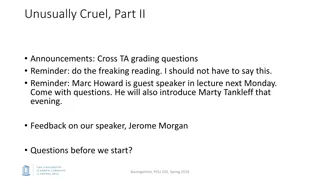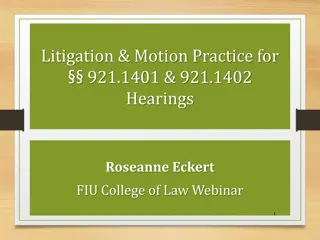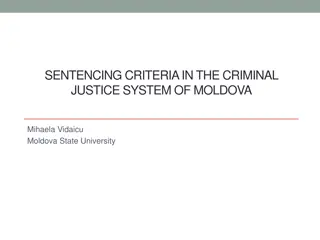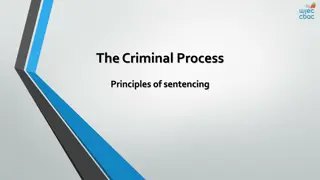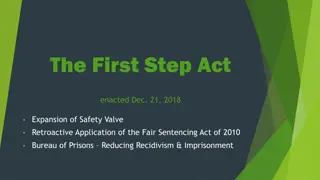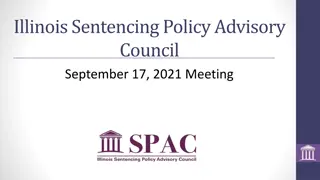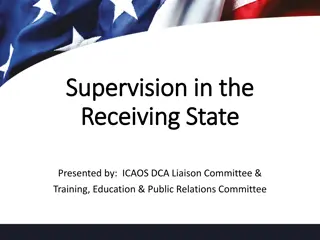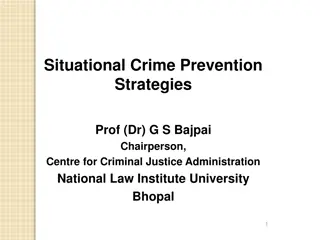Understanding Sentencing of Young Offenders
Explore the judicial processes and options available for sentencing young offenders, focusing on rehabilitation and reformation. Learn about the age of criminal responsibility, types of sentences, and considerations under the Criminal Justice and Immigration Act 2008. Discover the effectiveness of reprimands and warnings in preventing further criminal behavior among young individuals.
Download Presentation

Please find below an Image/Link to download the presentation.
The content on the website is provided AS IS for your information and personal use only. It may not be sold, licensed, or shared on other websites without obtaining consent from the author. Download presentation by click this link. If you encounter any issues during the download, it is possible that the publisher has removed the file from their server.
E N D
Presentation Transcript
Sentencing of Young Offenders
Sentencing Young Offenders Remember that the age of criminal responsibility is 10 Offenders who are under 18 are dealt with differently from adults Sentences available vary depending on the age of the offender The focus of sentencing for this age group is on rehabilitation and reformation.
Sentencing Young Offenders Before ending up in Court, young offenders can be subject to the system of reprimands and warnings to try and prevent them entering the justice system. Find out how the system of reprimands and warnings works and discuss whether you think it is an effective way to prevent the young offender committing further crimes.
Sentencing Young Offenders Since the Criminal Justice and Immigration Act 2008 when sentencing a young offender the court must have regard to: The principal aim of the youth justice system to prevent offending; The welfare of the offender; and The purpose of sentencing. s.9 of the Act lays down the purposes of sentencing young offenders, these are: Punishment; Reform and rehabilitation; The protection of the public; The making of reparation by offenders to persons affected by their offences.
Sentencing Young Offenders There are four main types of sentences: Custodial sentences Community sentences Fines Discharges There are other sentences available specifically for Young Offenders. These address their particular needs and meet the theories of crime applicable to this age group.
Custodial Sentences As a last resort, for serious offences, considering the history of the offender and the potential risk they pose, the Courts can sentence the young offender to a period of detention in a secure facility. The courts cannot send a child under the age of 18 to prison, instead they will be sent to a young offender institution, a secure training centre or a secure children's home.
Youth Offender Institutions Run by the Prison Service and private companies Provide secure accommodation for 15-21 year olds The offender to staff ratio in these institutions is higher than in other forms of secure accommodation for young offenders so are not considered the best way to deal with vulnerable young offenders who may be a risk to themselves or others.
Secure Training Centres Run by private companies under strict conditions Provide secure accommodation for offenders up to 17 years of age There are currently only a limited number of these institutions in operation across the country They focus on providing appropriate education and rehabilitation in order to prevent re-offending and have high numbers of staff per offender in order to meet that objective Staff develop links with each offender s local community in order to ensure the offender is rehabilitated effectively and can hopefully return to work or education opportunities which is also intended to prevent re-offending.
Secure Childrens Homes Run by local authorities and social services Generally for 12-14 year olds but will take girls and vulnerable boys up to age 16 They cater to the physical, emotional and behavioural needs of the children in their care individually and have high numbers of staff to do this.
Custodial Sentences There are two types of detention that can be given: Detention and Training Order Detention under s90/91 of the Powers of the Criminal Courts (Sentencing) Act 2000.
Custodial Sentences Detention and Training Orders Given to offenders between the ages of 12 and 17years who have committed serious offences. They can last anything from 4 months to 2 years. The first half is spent in custody while the second half is spent in the community under the supervision of the Youth Offending Team. Given to young offenders who represent a high level of risk, have a significant offending history or are persistent offenders and where no other sentence will manage their risks effectively.
Custodial Sentences Detention under s90/91 of the Powers of the Criminal Courts (Sentencing) Act 2000 Applies when a young person is convicted of an offence for which an adult could receive at least 14 years in custody. This sentence can only be given in the Crown Court. Section 90 is the mandatory life sentence applicable to young offenders known as Detention at Her Majesty s Pleasure . As with adults, the young offender will be set a minimum tariff to serve, after which time they can be released on licence. See R v Sec of State for the Home Department, ex parte Venables and Thompson (1997) and T v UK and V v UK (2000) Section 91 allows the court to give anything up to the maximum sentence that applies to adults convicted for that offence. They will serve the sentence in an appropriate form of custody see later notes. They are released automatically at the halfway point and could be released up to a maximum of 135 days early on Home Detention Curfew if deemed suitable. They are then released on licence or under supervision.
Youth rehabilitation orders The Criminal Justice and Immigration Act 2008 created the Youth Rehabilitation Order, it replaced a range of different orders available for young offenders, including action plan orders, supervision orders, drug treatment and testing orders, curfew orders, attendance centre orders, exclusion orders and community orders. The system for sentencing young offenders now takes a scaled approach to sentencing and focuses attention particularly on those offenders most at risk of re-offending or causing serious harm to themselves or others. This simplifies the system for sentencing young offenders a little and focuses on rehabilitation as the method for dealing with these young offenders. .
Youth rehabilitation orders When imposing a youth rehabilitation order a court must choose from a list of requirements that the offender must comply with, they include: An activity requirement; A supervision requirement An unpaid work requirement; A programme requirement; An attendance centre requirement; A prohibited activity requirement; An exclusion requirement; A residence requirement; A local authority residence requirement; A local authority residence requirement; A mental health treatment requirement A drug treatment requirement; A drug testing requirement; An intoxicating substance requirement; An education requirement; An electronic monitoring requirement; Intensive supervision and surveillance requirement Intensive fostering; A curfew requirement.
Reparation Orders s.73 PCC(S)A 2000 Offenders under 18 years Designed to get offenders to understand the consequences of their actions, empathise with their victims and take responsibility for their actions. Offender is ordered to make reparation to the victim(s) (with their consent) or to the wider community. Maximum 24 hours which must be completed within 3 months of the date of the order. Must be completed under supervision.
Referral Orders Available for first time offenders who plead guilty provided that the offence is not so serious as to require a custodial sentence or so minor as to warrant only a minor sentence. The offender signs up to a contract to address their offending behaviour. This contract is agreed with the Youth Offender Panel and the offender s parents and victim if appropriate . The contract lasts for between 3 and 12 months. Referral orders differ from custodial sentences in that once the term of the contract is complete, the conviction is regarded as spent so does not need to be disclosed on application forms for jobs.
Child Safety Order ss 11-13 Crime and Disorder Act 1998 Applies to children under the age of 10, despite the fact that the age of criminal responsibility is 10 It is designed to be used where children under 10 have committed an offence or breached a child curfew or been involved with anti- social behaviour The child is placed under supervision of the Youth Offending Team and has to comply with terms of the order. If they do not comply with the terms, the child s parents can become subject to a parenting order in order to try and address the child s offending behaviour before it becomes an insurmountable problem.
Parenting Orders S.8 of the Crime and Disorder Act 1998 Can be given to parents of children who offend, play truant from school or who have already been subject to orders from the court. Parent does not get a criminal record. Counselling and guidance will be given to parents for up to 3 months. Orders can have conditions attached which can last for up to 12 months e.g. that parents attend meetings with teachers at the child s school or that they are home at a specified time. Parents can be prosecuted if they don t comply with the conditions.
Fines As with adults, the fine should reflect the offence committed and the offender s ability to pay. For offenders under 16, paying the fine is the responsibility of a parent/guardian and it will be their ability to pay that is taken into account when setting the level of the fine. The maximum fine that can be given to someone under 14 years old is 250. If the youth is over 13 and under the age of 18 the maximum fine is 1,000. Who do you think pays these fines? What issues does this cause?
Discharges Two types absolute and conditional Usually used for first time offenders Can only use conditional discharges in exceptional circumstances following the Crime and Disorder Act 1998 Offender will not be punished for the current offence provided they commit no further offences for a specified period between 6 months and 3 years With absolute discharges no punishment will be given despite the offender either pleading guilty or being found guilty of the offence.
Youth Offending Teams (YOTs) Youth Offending Teams work with young offenders The Youth Justice Board s website states the following about YOTs: There is a YOT in every local authority in England and Wales. They are made up of representatives from the police, Probation Service, social services, health, education, drugs and alcohol misuse and housing officers. Each YOT is managed by a YOT manager who is responsible for co-ordinating the work of the youth justice services. Because the YOT incorporates representatives from a wide range of services, it can respond to the needs of young offenders in a comprehensive way. The YOT identifies the needs of each young offender by assessing them with a national assessment. It identifies the specific problems that make the young person offend as well as measuring the risk they pose to others. This enables the YOT to identify suitable programmes to address the needs of the young person with the intention of preventing further offending .
